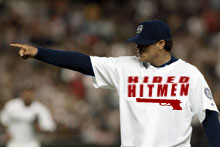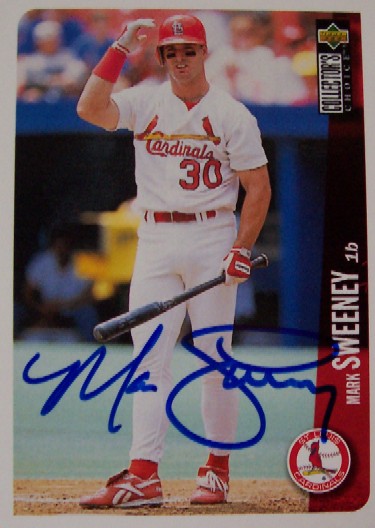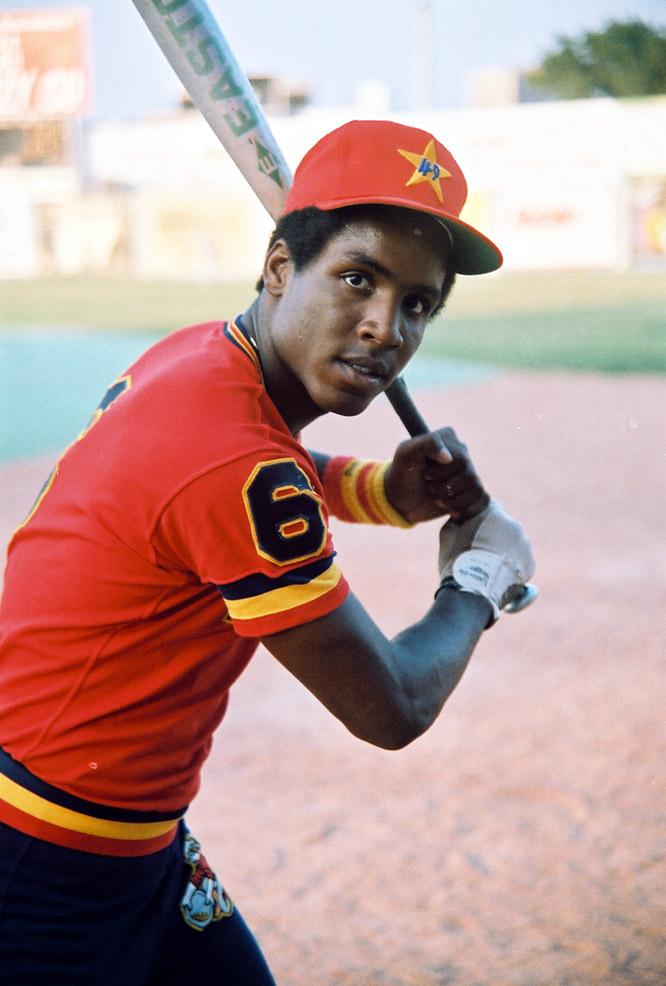The protected lists are in and the
15th Diamond Mind Baseball Draft is just around the corner! To
celebrate, Did You Know asks
the tough questions about players eligible for the upcoming DMBL season.
Making a Special Appearance
How many players are eligible this year, anyway?
 There are 683 players eligible: 320 batters and
363 pitchers (163 starters, 190 relievers and 10 swing men). Of the
batters, there are 40 eligible at catcher; 63 at first base; 60 at
second base; 55 at third base; 52 at shortstop; 133 at outfield; and
just one (Travis Hafner)
eligible only at DH. (Remember several players are eligible at two or
more positions, so it adds up to more than 320 batters.) Of the
catchers, seven can only be used as catchers; they had enough plate
appearances to qualify as catchers, but not as general hitters.
There are 683 players eligible: 320 batters and
363 pitchers (163 starters, 190 relievers and 10 swing men). Of the
batters, there are 40 eligible at catcher; 63 at first base; 60 at
second base; 55 at third base; 52 at shortstop; 133 at outfield; and
just one (Travis Hafner)
eligible only at DH. (Remember several players are eligible at two or
more positions, so it adds up to more than 320 batters.) Of the
catchers, seven can only be used as catchers; they had enough plate
appearances to qualify as catchers, but not as general hitters.
Speaking of which, before the start of last season, the DMBL adopted a
new rule to
determine batter eligibility. Instead of using at-bats, the standard
became plate appearances. (The number remained the same: 200 for
catchers, 250 for everybody else).
This year, 23 players (including four catchers) are eligible under the
new plate-appearance rule; that's up from last year, when 20 "extra"
players
(also including four catchers) got in. This year,
David Newhan
was just one plate appearance shy of making it, with 218 at-bats, 22
walks, 2 hit-by-pitch, five sac bunts and two sac flies adding up to
249 plate appearances. But since he hit .202 with a .591 OPS, no one
would have drafted him anyway... The catcher who came closest, Dioner Navarro, would have garnered more
attention: In his 199 plate appearances, he hit .273 with a .729 OPS,
and is only 21 years old. Maybe next year!
 The pitching eligibility rule has remained the
same for years: 10 starts for starting pitchers, and 30 games (at least
10 in relief) for relievers. Four starters just missed the cut, with
only nine starts. (Joaquin Benoit also had nine
starts, but he's eligible as a reliever thanks to his 32 appearances,
23 in relief.) Of the four, Darrell May (1-4,
6.78 ERA, 14.9 R/9) and Paul Wilson (1-5, 7.77
ERA, 17.3 R/9) wouldn't have received any consideration anyway, but
there likely would have been a lot of interest in Scott
Baker (3-3, 3.35 ERA, 10.4 R/9 in 10 games, 9 starts) and Aaron Small (10-0, 3.20 ERA, 11.8 R/9 in 15
games, 9 starts) if they'd only made one more start!
The pitching eligibility rule has remained the
same for years: 10 starts for starting pitchers, and 30 games (at least
10 in relief) for relievers. Four starters just missed the cut, with
only nine starts. (Joaquin Benoit also had nine
starts, but he's eligible as a reliever thanks to his 32 appearances,
23 in relief.) Of the four, Darrell May (1-4,
6.78 ERA, 14.9 R/9) and Paul Wilson (1-5, 7.77
ERA, 17.3 R/9) wouldn't have received any consideration anyway, but
there likely would have been a lot of interest in Scott
Baker (3-3, 3.35 ERA, 10.4 R/9 in 10 games, 9 starts) and Aaron Small (10-0, 3.20 ERA, 11.8 R/9 in 15
games, 9 starts) if they'd only made one more start!
Six relievers had 29 appearances, one shy of making it; but no one's missing out on much. Tommy Phelps had the best ERA of the group, at 4.63.
That Age-Old Question
Who's the youngest eligible player
this year?
SP Felix
Hernandez,  who was born April 8, 1986. That's right --
he'll still
be a
teenager at the start of the 2006 season! The right-handed rookie won't
turn 20 until several weeks after the draft, where he would have been a
lock for the first-round (4-4, 2.67 ERA, 1.00 WHIP in 12 starts) --
if he hadn't been protected by the Hillsborough Hired Hitmen. GM Brent Campbell presciently selected Hernandez,
an ineligible Double-A player at the time, with the first pick in the
fourth round (#43 overall), in last year's draft... The next-youngest
player will be available in the draft: Rookie RP Marcos
Carvajal, who enters the 2006 season as a 21-year-old (born Aug.
19, 1984). He posted a 5.09 ERA, though, so age is all he has going for
him.
who was born April 8, 1986. That's right --
he'll still
be a
teenager at the start of the 2006 season! The right-handed rookie won't
turn 20 until several weeks after the draft, where he would have been a
lock for the first-round (4-4, 2.67 ERA, 1.00 WHIP in 12 starts) --
if he hadn't been protected by the Hillsborough Hired Hitmen. GM Brent Campbell presciently selected Hernandez,
an ineligible Double-A player at the time, with the first pick in the
fourth round (#43 overall), in last year's draft... The next-youngest
player will be available in the draft: Rookie RP Marcos
Carvajal, who enters the 2006 season as a 21-year-old (born Aug.
19, 1984). He posted a 5.09 ERA, though, so age is all he has going for
him.
The oldest player, for the billionth year in a row, is 1B Julio Franco. The ageless wonder will turn 48 this summer (born Aug. 23, 1958). He's the last active player born in the 1950s! Oddly enough, the second-oldest player is -- no relation -- John Franco. The lefty reliever as born Sept. 17, 1960, so he will spend almost the entire 2006 season as a mere 45-year-old. The two Francos are joined by 20 other players who are at least 40 this season -- 16 pitchers and just six batters (Craig Biggio, Jeff Conine, Steve Finley, Rafael Palmeiro, B.J. Surhoff and Julio Franco). Oddly enough, of the 16 players who start the year at age 22 or younger, just two -- Jeff Francouer and Brian McCann -- are batters.
One final piece of age-related trivia: The average
eligible player is 30.1 years old this season.
The Freshman Class
How many rookies are there this year?
Well, I'm not going to steal Phil Plantier's Rookie Watch thunder,
but I will tell you there are 114 of 'em -- 53 batters and
61 pitchers. A player has rookie status, you will recall, if this is
his first year of eligibility in the DMBL, regardless of whether he's
ever been drafted. Therefore, some guys are rookies (like Joe Mauer) even though they've been on a team's
roster for a couple years, while others (like Tanyon
Sturtze) aren't rookies even though they've never made a DMBL team.
 The gold medal for oldest rookie goes
to reliever Dae-Sung Koo, who will turn 38
this season (born Aug. 2, 1968). Koo has been eligible in the Korea
DMBL since 1993, when he made his debut with the Hanwha Eagles, and in
the Japanese DMBL since 2001, when he pitched 51 games for the Orix
Blue Wave. The silver and bronze go to two other imports from the Far
East, reliever Keiichi Yabu (Sept. 28, 1968)
and outfielder So Taguchi (July 2, 1969).
The gold medal for oldest rookie goes
to reliever Dae-Sung Koo, who will turn 38
this season (born Aug. 2, 1968). Koo has been eligible in the Korea
DMBL since 1993, when he made his debut with the Hanwha Eagles, and in
the Japanese DMBL since 2001, when he pitched 51 games for the Orix
Blue Wave. The silver and bronze go to two other imports from the Far
East, reliever Keiichi Yabu (Sept. 28, 1968)
and outfielder So Taguchi (July 2, 1969).
The flip side of the coin is the
youngest non-rookie: SP Zack
Greinke, who won't turn 23 until the end of next season (born Oct.
21, 1983). Greinke was drafted as a 20-year-old prospect by Philly in
the 6th round (#76) of the 2004 draft, then protected him entering last
season. But Greinke wasn't protected after bombing as a rookie with the
Animals (9-11, 5.30 ERA).
Never Give Up
What award did Mark
Sweeney win this year?
 Sweeney won two dubious honors: He is the
oldest rookie (born Oct. 26, 1969) not
from the
Japanese League, and he also wins the Jeff Reboulet
Perseverance Award as the DMBL rookie with the most MLB experience.
(Jeff Reboulet played 11 MLB seasons -- 925
games, 1,968 at-bats -- before finally becoming eligible at age 39 for
the 2004 season. His life's ambition accomplished, Reboulet then
retired. However, he never made a DMBL roster.) Most people are
familiar with Mike Sweeney, a long-time member
of the Tijuana Banditos who has been eligible in the DMBL for eight
seasons; this is the other Sweeney, who played in 765 MLB games (1,135
at-bats) over 10 seasons, for six different teams, before finally
becoming eligible this season. And Sweeney still didn't make it easy on
himself, with just 221 at-bats; he's eligible this year because of the
rule, adopted in 2004, that changed eligibility from 250 at-bats to 250
plate appearances. (More on that rule later.) Sweeney's 40 walks pushed
him over the top.
Sweeney won two dubious honors: He is the
oldest rookie (born Oct. 26, 1969) not
from the
Japanese League, and he also wins the Jeff Reboulet
Perseverance Award as the DMBL rookie with the most MLB experience.
(Jeff Reboulet played 11 MLB seasons -- 925
games, 1,968 at-bats -- before finally becoming eligible at age 39 for
the 2004 season. His life's ambition accomplished, Reboulet then
retired. However, he never made a DMBL roster.) Most people are
familiar with Mike Sweeney, a long-time member
of the Tijuana Banditos who has been eligible in the DMBL for eight
seasons; this is the other Sweeney, who played in 765 MLB games (1,135
at-bats) over 10 seasons, for six different teams, before finally
becoming eligible this season. And Sweeney still didn't make it easy on
himself, with just 221 at-bats; he's eligible this year because of the
rule, adopted in 2004, that changed eligibility from 250 at-bats to 250
plate appearances. (More on that rule later.) Sweeney's 40 walks pushed
him over the top.
Todd Pratt, meanwhile, remains the player with the most MLB service time still not eligible for the DMBL. Pratt made his MLB debut in 1992, racking up 600 games and 1,477 at-bats, but never enough in one season to get into a DMBL game. Adding to Pratt's frustration is the fact that, as a catcher, he needs just 200 plate appearances to qualify, but still can't make it. This year he missed by just 4 plate appearances! Hang in there, Todd: You've got a shot this year via the Tom Prince Rule. The bad news, though, is the rule -- which makes an extra player eligible if no other free agents are available at that position -- has never been needed.
You're Still Here?
What members of the Class of 1991 are still eligible?
Yes, like World War I veterans and KISS fans, every year there are
fewer of
them, yet they still haven't gone away completely.  Just four players have been eligible in every
DMBL season way back to our inaugural 1991 season: Craig
Biggio, then a catcher with the Vancouver Ironfist (.345, .799 OPS
in 142 AB); Austin Outlaws SP Roger Clemens
(14-8, 3.26 ERA); Austin 1B Rafael Palmeiro
(.297, .741 OPS in 377 AB); and Newark Crimewave SP David
Wells (8-16, 4.23 ERA). Biggio, Clemens and Palmeiro have played in
every DMBL season, while Wells, who has been eligible every year,
didn't appear in a game in 1992... The list was shortened by two this
year, with Barry Bonds and Marquis
Grissom failing to make the cut for the first time in league
history. Grissom, though eligible every season since the league
started, didn't make a roster in '91 or from '99-02; Bonds, on the
other hand, had played in every DMBL season, all for Arkansas.
Just four players have been eligible in every
DMBL season way back to our inaugural 1991 season: Craig
Biggio, then a catcher with the Vancouver Ironfist (.345, .799 OPS
in 142 AB); Austin Outlaws SP Roger Clemens
(14-8, 3.26 ERA); Austin 1B Rafael Palmeiro
(.297, .741 OPS in 377 AB); and Newark Crimewave SP David
Wells (8-16, 4.23 ERA). Biggio, Clemens and Palmeiro have played in
every DMBL season, while Wells, who has been eligible every year,
didn't appear in a game in 1992... The list was shortened by two this
year, with Barry Bonds and Marquis
Grissom failing to make the cut for the first time in league
history. Grissom, though eligible every season since the league
started, didn't make a roster in '91 or from '99-02; Bonds, on the
other hand, had played in every DMBL season, all for Arkansas.
In addition to Biggio, Clemens, Palmeiro and Wells, there are six other
players are eligible this year, 15 years after playing in the DMBL's
inaugural season: John Franco (Newark
Crimewave), Julio Franco (Vancouver), Ken Griffey Jr. (Vancouver), Randy
Johnson (Maine Lobsters), Gary Sheffield
(Newark Crimewave) and B.J. Surhoff (Austin). John Smoltz was eligible and was drafted by
Vancouver, but didn't make an appearance that year. Each of these
players, including Smoltz, wasn't eligible at least once after the 1991
season, however.
In addition to Bonds, other Class of '91 players not eligible this year
this year are Barry Larkin,
Edgar Martinez and Ruben Sierra. Unlike Bonds, however, each has
missed being eligible at least once before.
Name Dropping
What's the most popular name this year?
 This year's winner among last names is Hernandez, with seven eligible players sharing
it: Felix, Jose, Livan, Orlando, Ramon, Roberto, and Runelvys. (Where
have you gone, Xavier Hernandez?) Tied for
second place, with six, are Johnson (Dan,
Jason, Kelly, Nick, Randy, and Reed), Rodriguez
(Alex, Felix, Francisco, Ivan, Ricardo, and Wandy) and Williams (Bernie, Dave, Jerome, Randy, Todd, and
Woody). The Johnsons missed their chance at a first-place tie thanks to
Charles Johnson, who wasn't
eligible for the first time in 10 seasons.
This year's winner among last names is Hernandez, with seven eligible players sharing
it: Felix, Jose, Livan, Orlando, Ramon, Roberto, and Runelvys. (Where
have you gone, Xavier Hernandez?) Tied for
second place, with six, are Johnson (Dan,
Jason, Kelly, Nick, Randy, and Reed), Rodriguez
(Alex, Felix, Francisco, Ivan, Ricardo, and Wandy) and Williams (Bernie, Dave, Jerome, Randy, Todd, and
Woody). The Johnsons missed their chance at a first-place tie thanks to
Charles Johnson, who wasn't
eligible for the first time in 10 seasons.
Next, with five, comes Gonzalez (Alex, Alex
S., Luis, Luis A., and Mike) and Walker
(Jamie, Larry, Pete, Todd, and Tyler); followed with four by Jones (Andruw, Chipper, Jacque, and
Todd), Lee (Carlos, Cliff, Derrek and Travis),
Lopez (Felipe, Javier, Javy,
and Rodrigo) and Perez (Antonio, Neifi,
Odalis, and Oliver). Tied for 11th place were 13 last names shared by
three players, including the Molina brothers
(Bengie, Jose and Yadier).
While most of the last names end in a "z", most of the first names are
anglicized.  The most popular first name is Mike, with 28 players sharing that name
(including four who prefer to be known as Michael,
but not including the five who go by Miguel).
Next is Jason, shared by 21 players (including
Jayson Werth but not Jason "Jay" Payton). Then there's 14 named John; 13 named David or Mark; 12 named Ryan
or Scott
(including the letter-challenged Scot Shields);
and 11 named Brian, Chris
or Matt. The most popular Hispanic first name
is Jose, with 12 players using it; no other
Hispanic first name cracks double digits.
The most popular first name is Mike, with 28 players sharing that name
(including four who prefer to be known as Michael,
but not including the five who go by Miguel).
Next is Jason, shared by 21 players (including
Jayson Werth but not Jason "Jay" Payton). Then there's 14 named John; 13 named David or Mark; 12 named Ryan
or Scott
(including the letter-challenged Scot Shields);
and 11 named Brian, Chris
or Matt. The most popular Hispanic first name
is Jose, with 12 players using it; no other
Hispanic first name cracks double digits.
Did You Know that Gregg Jefferies set the record for most DMBL franchises played for when he retired in 1999? The former Columbia Crusader, Arkansas Golden Falcon, Waikiki Key, Jerusalem Rabbi, Honolulu Shark, Carolina Mudcat, Newark Sugar Bear, Hawaii Volcano and Vancouver Iron Fist also has the distinction of having played for all three franchises located in the 50th state. Jefferies hit .283 (.734 OPS) in 2,392 at bats over eight DMBL seasons. Click Here for past articles.